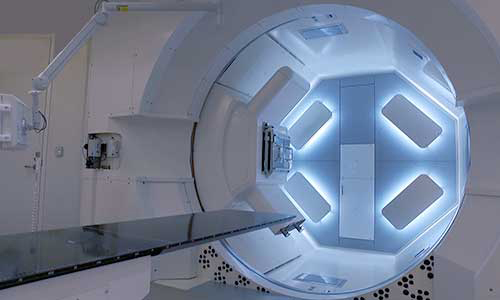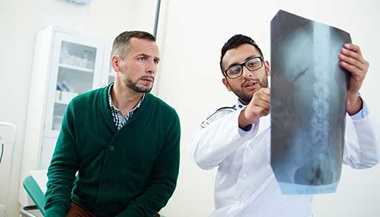Spinal Cord Tumor Overview
A tumor forms when an abnormal cell grows to form a mass of abnormal cells. Spinal cord tumors are tumors that form on the spinal cord or in the area around it.
A spinal cord tumor may be cancerous (malignant) or noncancerous (benign). Even if benign, a tumor often causes pain and discomfort because it pushes on the spinal cord or nerves.
A spinal cord tumor may be called “primary,” which means the cancer started in the spinal cord, or “secondary,” which means the cancer started somewhere else in body and spread to the spinal cord. Most of the time, spinal cord tumors are secondary tumors. A spinal cord tumor is often a cancer of the lung, breast, prostate, or another cancer that has extended throughout the body to reach the spine.
Spinal cord tumors are sometimes caused by a genetic disorder, like neurofibromatosis.
Facts about spinal cord tumors
Spinal cord tumors are relatively uncommon. It's much more common to develop a brain tumor than a tumor on the spinal cord. A spinal cord tumor may form inside the spinal cord itself or around the bones that make up the spine. Spinal cord tumors cause problems with the nerves, blood vessels, and bones.
Some spinal cord tumors can be successfully treated. The earlier you tell your doctor about your symptoms, get a diagnosis, and start treatment, the better your outcome is likely to be. But spinal cord tumors often cause permanent damage to the nerves and result in disability.
Types of spinal cord tumors
Spinal cord tumors affect many different areas and come in many different types, including:
-
Leukemia or lymphoma, cancers of the blood
-
Myeloma, cancer of the bone marrow
-
Medulloblastomas, which start in the brain and metastasize to the spine, and are most common in children
-
Gliomas (ependymomas, astrocytomas, or gangliogliomas), which are cancers that form in cells called glial cells
-
Chordomas, which form in the spine and can push against it
-
Schwannomas, which start inside the peripheral nerves
-
Meningiomas, which start in the tissues around the spinal cord (meninges)
-
Metastatic (secondary) tumors, which are cancers that have spread from the lung, breast, prostate, or other organs
Symptoms
Spinal cord tumors can cause many different symptoms:
-
Inability to control the bowels and/or bladder
-
Weak muscles that you can't seem to control so that you fall or have trouble walking
-
Muscle spasms
-
An unusual feeling or sensation in the legs
-
Feeling cold in the hands, fingers, or legs
Spinal cord tumors often cause back pain, including:
-
Feeling worse when you strain in any way, sneeze, or cough
-
Increased pain when you lie down
-
Pain that’s specific to the spine
-
Extreme pain that isn't improved by taking medicine
-
Pain that feels worse as time passes
-
Pain that spreads into the arms, feet, legs, or hips
Diagnosis
A doctor will usually do a neurologic exam to diagnose a spinal cord tumor. The exam will look for these signs:
-
Soreness in the area of the spine
-
Inability to feel pain, heat, or cold
-
An abnormal reflex response
These tests can help your doctor see a spinal cord tumor and find out more information about it:
-
Imaging tests of the spine, such as a CT scan, MRI, or myelogram, which uses an X-ray in combination with an injection of contrast dye into the spine to better see the tumor
-
Hormone tests
-
Biopsy (removal of small pieces of the tumor to determine what type it is)
-
Exam of the cerebrospinal fluid and the cells in the fluid
Treatment
Treatment for a spinal cord tumor is different for everyone and depends on the type of tumor, its location, and your overall health. These are treatment options:
-
Surgery to remove all or part of the tumor
-
Radiation therapy, which is sometimes used in addition to surgery
-
Chemotherapy
-
Corticosteroid medications to lessen swelling
Some types of spinal tumors require radiation of the whole spine. This procedure, called craniospinal radiation, can lead to anemia and other side effects. When there is radiation to the lumbar spine, fertility needs to be considered.
Prevention
Since it's not understood why most primary spinal cord tumors develop, experts don't know how to prevent them.
Managing spinal cord tumors
Working with your doctor can help you to ease your symptoms so that you feel more comfortable before and during treatment.
After your treatment, you may need physical therapy to strengthen muscles and help them work properly again.
During the course of your treatment, always tell your doctor or seek emergency help if your symptoms suddenly become more severe or change in some way.
Finding additional resources
Joining a support group for people with cancer or spinal cord problems can be helpful when you're battling a spinal cord tumor.
To find out more information about spinal cord tumors, you may want to contact:
Key points to remember
If you are currently undergoing treatment for any type of cancer and develop back pain, you should let your doctor know right away. It's also a good idea to contact your doctor about any back pain that worsens or doesn't go away with time.
The Johns Hopkins Proton Therapy Center

Proton therapy is used to treat certain tumors in children and adults. Our treatment center, located at Sibley Memorial Hospital in Washington, D.C., combines advanced proton therapy technology, the latest research and caring specialists.





